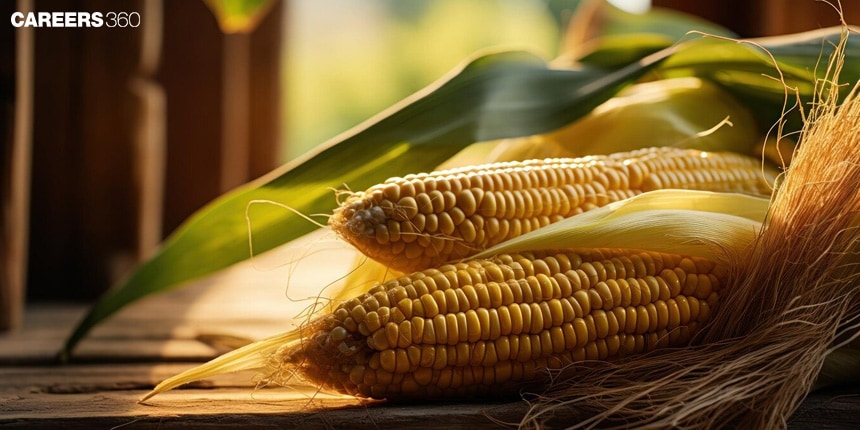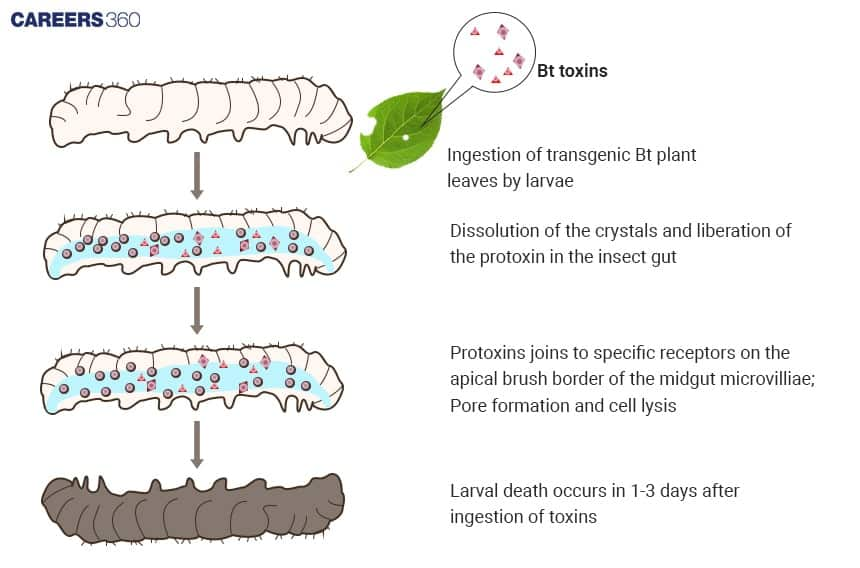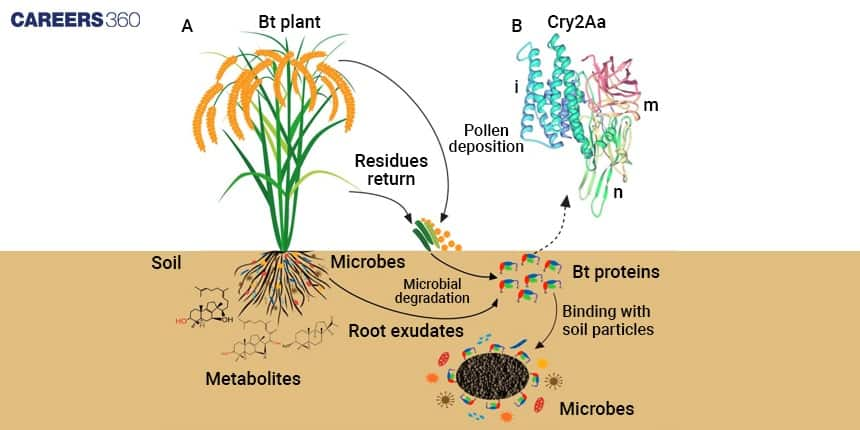Bt Crops: Definition, Types, Examples, Diagram, Questions, Process
Bt crops are genetically engineered plants that produce a natural insecticide derived from the Bacillus thuringiensis bacterium. This biological solution allows plants, such as Bt cotton and Bt maize, to resist specific pests, reducing the need for chemical pesticides and enhancing crop yields. Bt seeds are modified with genes that enable the plant to produce proteins toxic to certain insects, such as the bollworm in Bt cotton. Being part of the Biotechnology part of Biology it becomes one of the important topics to cover from an examination point of view.
NEET 2025: Mock Test Series | Syllabus | High Scoring Topics | PYQs
NEET Important PYQ's Subject wise: Physics | Chemistry | Biology
New: Meet Careers360 B.Tech/NEET Experts in your City | Book your Seat now
- What are Bt crops?
- Mechanism of Bt Toxin in Pest Control
- Development of Bt Crops
- Types of Bt Crops
- Advantages of Bt Crops
- Disadvantages of Bt Crops
- Bt Crops and Global Agriculture
- Future Prospects of Bt Crops
- Recommended video for Bt Crops

What are Bt crops?
Bt crops are transgenic plants genetically engineered with the DNA of the Bacillus thuringiensis bacteria.
Bt crops, genetically modified to include the insecticidal proteins of Bacillus thuringiensis, have played a huge role in current agriculture. The most common Bt crops include Bt cotton and Bt maize, which have been widely adopted for their pest-resistant properties.
Also Read:
Bacillus thuringiensis: The Bacterium Behind Bt Crops
Bacillus thuringiensis is a soil bacterium that produces certain proteins toxic to specific kinds of insects. This is one of the best examples of Bt crops. The toxins produced by Bt bind to the receptors in the gut of the target insects, causing cell lysis and death, providing a natural pest control mechanism.
Mechanism of Bt Toxin in Pest Control
Following are the steps by which the Bt toxin can work:
Ingestion: Target pests ingest Bt proteins while feeding on the plant.
Binding: The Bt toxin binds to specific receptors in the insect's gut.
Cell Lysis: The binding causes cell membranes to break down, leading to gut paralysis and eventual death of the insect.
Diagram of Bt cotton

Development of Bt Crops
Advanced techniques of biotechnology are incorporated in developing Bt crops, such as
Bt Gene Isolation: The gene involved in the production of Bt toxin is isolated from the bacterium.
Transferring of Bt Gene: The Bt gene is transferred into the plant genome by the vectors.
Selection: The selection of plants that are successfully transformed for the further breeding process, leads to their development.
Types of Bt Crops
The types of Bt Crops are listed below:
Bt Crop | Targeted Pests | Advantages |
Bt Cotton | Bollworm, pink bollworm | Reduces the use of pesticides, enhancing crop yield |
Bt Maize | European corn borer, rootworm | Provides better crop protection with increased productivity |
Bt Brinjal | Fruit and shoot borer | Reduces pest damage, improves fruit quality |
Advantages of Bt Crops
The advantages of Bt Crops are listed below-
Enhanced Pest Resistance: Bt crops provide effective resistance to target insect pests, thus minimizing crop losses and maximizing agricultural outputs.
Reduced Need for Chemical Pesticides: Bt crops reduce the use of chemical pesticides, leading to a safer environment.
Increased Crop Yield and Quality: Benefits to the farmers in terms of better yield and quality of crops due to effective control of pests by Bt crops.
Environmental Benefits: Diminished use of chemical pesticides will reduce the number of environmental pollutants and enhance biodiversity.
Disadvantages of Bt Crops
The disadvantages of Bt Crops are listed below-
Development of Pest Resistance: Continuous use of Bt toxins may develop resistance in the target pest populations, and thereby, IPM will be required.
Impact on Non-Target Organisms: Potential impact of Bt crops on nontarget organisms such as beneficial insects and soil microorganisms may be impacted.
Biodiversity Concern: Local biodiversity may be affected due to the popularization of Bt crops if non-targets are affected, and genetic diversity among crops may be reduced.
Ethical and Regulatory Issues: Bt crops are the products of GMOs and raise concerns regarding their ethical nature and their rigorous clearance from various regulatory bodies to be safe for human beings and the environment.
Diagram: Potential Ecological Impacts Of Bt Crops

Bt Crops and Global Agriculture
Adoption Rates Worldwide of Bt Crops are discussed below:
The global adoption of Bt crops has been monitored and recorded with the following remarkable success stories.
Bt Cotton in India led to a significant reduction in pesticide use and an increase in yields.
Bt corn in the United States is observed to increase crop health and yield.
Economic Impacts on Farmers
Economic gains for farmers adopting Bt crops include reduction in costs of pesticides and a considerable increment in crop yields hence bettering their economic status.
Regulatory Framework and Safety Assessment
When new Bt crops are developed, they are passed through safety tests and efficacy trials by regulatory bodies. The registration phase for Bt crops must pass through rigorous field evaluations, laboratory and extensive risk assessment. As a result, there have been no significant studies implicating long-term human health and environmental effects on Bt crops, and they can be used continually in agriculture.
Future Prospects of Bt Crops
Research is still ongoing in Bt, developing new varieties with strong traits and resistance to a wider range of pests. Their role in the agriculture system can continuously be enhanced through Bt stacking and integration with other sustainable farming practices, such as crop rotation and biological controls, among other practices, to enhance agricultural sustainability.
Also Read:
Recommended video for Bt Crops
Frequently Asked Questions (FAQs)
Transgenic crops, engineered to express the bacterium Bacillus thuringiensis and its toxins targeted against specific insect pests.
Bt crops produce a protein that, when ingested by specific classes of insects will bind to the cells in the gut. This will lead to the rupture of cells and eventually death.
Reduced usage of insecticides, higher yield of crops, and better crop quality.
Extensive safety evaluations conducted by the regulatory authorities have confirmed the safety of Bt crops to humans and the environment.
Major risks associated with Bt crops include resistance development in target pests, risk to non-target organisms, and the biodiversity impact.
Also Read
22 Nov'24 12:15 PM
11 Nov'24 07:51 AM
24 Oct'24 10:12 AM
23 Oct'24 09:13 AM
22 Oct'24 11:05 AM
22 Oct'24 10:04 AM
01 Oct'24 09:23 AM